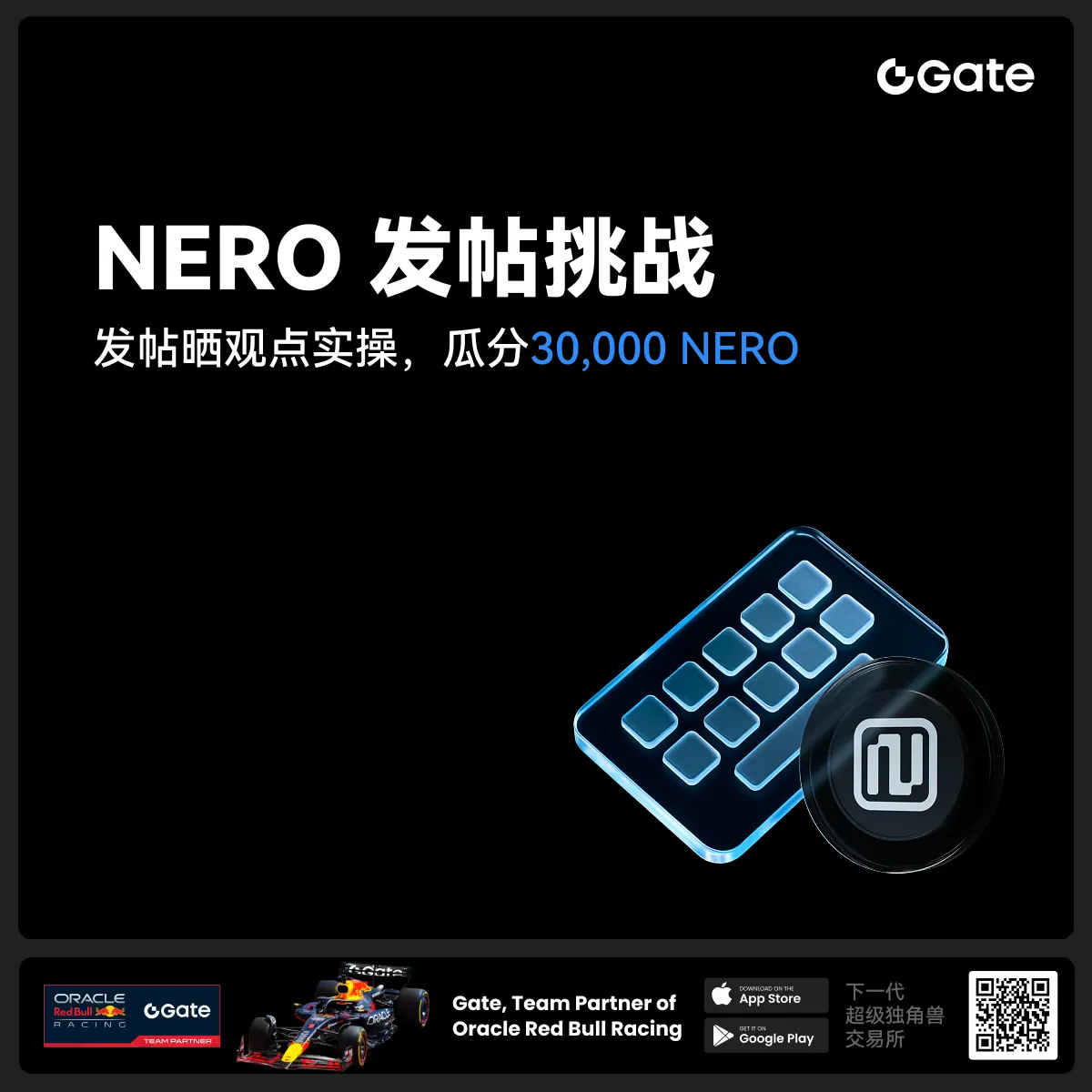- 话题1/3
27519 热度
17924 热度
36332 热度
7623 热度
18710 热度
- 置顶
- 🎉 #CandyDrop合约挑战# 正式开启!参与即可瓜分 6 BTC 豪华奖池!
📢 在 Gate 广场带话题发布你的合约体验
🎁 优质贴文用户瓜分$500 合约体验金券,20位名额等你上榜!
📅 活动时间:2025 年 8 月 1 日 15:00 - 8 月 15 日 19:00 (UTC+8)
👉 活动链接:https://www.gate.com/candy-drop/detail/BTC-98
敢合约,敢盈利
- 🎉 攒成长值,抽华为Mate三折叠!广场第 1️⃣ 2️⃣ 期夏季成长值抽奖大狂欢开启!
总奖池超 $10,000+,华为Mate三折叠手机、F1红牛赛车模型、Gate限量周边、热门代币等你来抽!
立即抽奖 👉 https://www.gate.com/activities/pointprize?now_period=12
如何快速赚成长值?
1️⃣ 进入【广场】,点击头像旁标识进入【社区中心】
2️⃣ 完成发帖、评论、点赞、发言等日常任务,成长值拿不停
100%有奖,抽到赚到,大奖等你抱走,赶紧试试手气!
截止于 8月9日 24:00 (UTC+8)
详情: https://www.gate.com/announcements/article/46384
#成长值抽奖12期开启#
- 📢 Gate广场 #NERO发帖挑战# 秀观点赢大奖活动火热开启!
Gate NERO生态周来袭!发帖秀出NERO项目洞察和活动实用攻略,瓜分30,000NERO!
💰️ 15位优质发帖用户 * 2,000枚NERO每人
如何参与:
1️⃣ 调研NERO项目
对NERO的基本面、社区治理、发展目标、代币经济模型等方面进行研究,分享你对项目的深度研究。
2️⃣ 参与并分享真实体验
参与NERO生态周相关活动,并晒出你的参与截图、收益图或实用教程。可以是收益展示、简明易懂的新手攻略、小窍门,也可以是行情点位分析,内容详实优先。
3️⃣ 鼓励带新互动
如果你的帖子吸引到他人参与活动,或者有好友评论“已参与/已交易”,将大幅提升你的获奖概率!
NERO热门活动(帖文需附以下活动链接):
NERO Chain (NERO) 生态周:Gate 已上线 NERO 现货交易,为回馈平台用户,HODLer Airdrop、Launchpool、CandyDrop、余币宝已上线 NERO,邀您体验。参与攻略见公告:https://www.gate.com/announcements/article/46284
高质量帖子Tips:
教程越详细、图片越直观、互动量越高,获奖几率越大!
市场见解独到、真实参与经历、有带新互动者,评选将优先考虑。
帖子需原创,字数不少于250字,且需获得至少3条有效互动
- 🎉 亲爱的广场小伙伴们,福利不停,精彩不断!目前广场上这些热门发帖赢奖活动火热进行中,发帖越多,奖励越多,快来GET你的专属好礼吧!🚀
1️⃣ #GateLaunchpad上线IKA# |IKA认购体验
在Gate广场带话题晒出你的IKA Launchpad认购体验,4位幸运分享者讲瓜分$200分享奖池!
详情 👉️ https://www.gate.com/post/status/12566958
2️⃣ #ETH冲击4800# |行情分析预测
大胆发帖预测ETH走势,展示你的市场洞察力!10位幸运用户将平分0.1 ETH 奖励!
详情 👉️ https://www.gate.com/post/status/12322403
3️⃣ #创作者活动第二期# |ZKWASM话题
在广场或推特发布与 ZKWASM 或其交易活动相关的原创内容,瓜分4,000枚ZKWASM!
详情 👉️ https://www.gate.com/post/status/12525794
4️⃣ #Gate广场征文活动第二期# |ERA话题
谈谈你对ERA的观点/体验,参与并推广活动,700 ERA大奖等你赢!
详情 👉️ https://www.gate.com/post/status/12361653
5️⃣ #MBG任务挑战# |MBG话题
分享你对MBG的洞察,积极参与和推广MBG活动,20位小 - 🎉Gate 2025 上半年社区盛典:内容达人评选投票火热进行中 🎉
🏆 谁将成为前十位 #Gate广场# 内容达人?
投票现已开启,选出你的心头好
🎁赢取 iPhone 16 Pro Max、限量周边等好礼!
📅投票截止:8 月 15 日 10:00(UTC+8)
立即投票: https://www.gate.com/activities/community-vote
活动详情: https://www.gate.com/announcements/article/45974
What Is a Consensus Algorithm in Crypto? - Tokenhell
Blockchain is the technology underlying decentralized s such as cryptocurrencies. For each one, there’s a method for coordinating the activities of the network, referred to as a consensus algorithm.
The consensus algorithm ensures that the parties involved in coordinating the network can agree on a single source of truth, regardless of the failure of some members. No single entity has the monopoly of control, so the network is run on the basis of trustlessness.
Yet, the members are able to come to agreement concerning how data is distributed, for example. In cryptocurrencies, this is achieved through a consensus mechanism, which ensures there’s immutability, privacy, security, and transparency.
A consensus algorithm is therefore a method through which all participating members of a blockchain network can come to an agreement about the state of the network. They can agree on what is true on the network and what isn’t, making the network secure.
Consensus Algorithms in Crypto
Consensus algorithms apply wherever the use of blockchain technology is applied. However, in cryptocurrencies, the algorithm is used mainly for verifying transactions and ensuring that no one cheats the .
There are many of them as we will see shortly, but they are all geared towards verifying transactions in a public manner, with many participants involved. Generally, crypto transactions are recorded in blocks, which come together to form the blockchain.
The transactions are verified by these participants called nodes – computers connected to the network – and added to the blocks. By helping to verify transactions through whichever algorithm, the nodes help to secure the network and are rewarded through an established unique to the crypto network.
There are different consensus algorithms used for cryptocurrencies, but here are the most common ones.
Proof-of-Work (PoW)
This is the first ever consensus algorithm, created by Satoshi Nakamoto who is also the creator of Bitcoin. The Bitcoin network is maintained through this algorithm, which requires confirming transactions by solving complex mathematical puzzles using specialized computers.
Node operators known as miners verify transaction blocks through a process known as mining, and in return are rewarded with a fixed amount of Bitcoins that is reduced by half roughly every four years.
There has been an argument that PoW is too energy-consuming, and so unhealthy for the environment. However, there’s an increasing use of clean energy for mining, which counters the argument.
Apart from Bitcoin other cryptocurrencies like Dogecoin, Litecoin, and many others also use PoW consensus algorithm.
Proof-of-Stake (PoS)
Proof-of-stake is a consensus algorithm that requires nodes to stake their assets in order to participate in transaction verification. Such participants are called validators. For Ethereum for example, validators are expected to own and stake at least 32 ether to qualify.
By staking their assets, validators are expected to do everything to ensure the integrity of the network and are in return rewarded with more tokens from transaction fees. There have been arguments that PoS compromises decentralization in order to increase scalability and lower transaction fees.
Examples of crypto networks that use this algorithm are Ethereum, Ethereum Classic, and many others.
Delegated Proof of Stake (DPoS)
This is a iation of the PoS consensus algorithm. Validators in this are delegated, hence the name. Rather than every staker participating in validating transactions, they delegate their responsibilities to a few individuals who will then serve as validators on the network.
After validating a block, the delegated validator then shares the rewards with those who delegated him. DPoS is even more centralized than PoS since the validators only delegate a few to do the actual validator’s work. Examples of cryptocurrencies using DPoS are Solana, Tron, and EOS.
Conclusion
Blockchain networks function through consensus algorithms, and so every cryptocurrency uses one. The argument about which one is better does not arise, because the choice of a consensus mechanism depends on the goal of the network.
However, it is generally said that PoW is energy-consuming and cumbersome, while PoS and DPoS are more scalable and faster, but centralized, which is contrary to the original idea of decentralization.
Tokenhell produces content exposure for over 5,000 crypto companies and you can be one of them too! Contact at info@tokenhell.com if you have any questions. Cryptocurrencies are highly volatile, conduct your own research before making any investment decisions. Some of the posts on this website are guest posts or paid posts that are not written by Tokenhell authors (namely Crypto Cable , Sponsored Articles and Press Release content) and the views expressed in these types of posts do not reflect the views of this website. Tokenhell is not responsible for the content, accuracy, quality, advertising, products or any other content or banners (ad space) posted on the site. Read full terms and conditions / disclaimer.